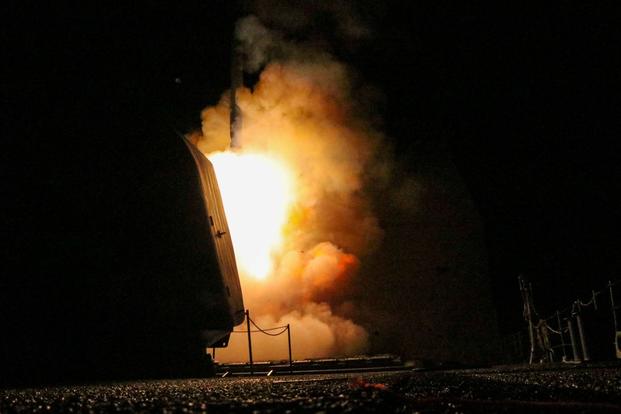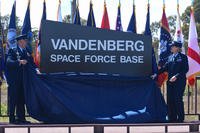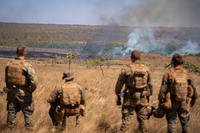Editor's Note: On April 19, U.S. Air Forces Central Command released information contradicting Marine Lt. Gen. Kenneth McKenzie's initial statements about the variant of Joint Air to Surface Stand-Off Missile used in the Syria strikes. The standard JASSM-A missile variant was used, not the new extended-range variant, officials said.
It was the first operational use for any JASSM variant, according to AFCENT.
It was all over in two minutes.
U.S., French and British forces hit three suspected Syrian chemical weapons facilities with a total of 105 weapons that all struck their targets within two minutes at about 4 a.m. local time, Pentagon officials said Saturday.
"Could not have had a better result -- Mission Accomplished!" President Donald Trump said in a Tweet early Saturday.
The attack involved ships, aircraft and one submarine operating from the Eastern Mediterranean, the Red Sea, and the Northern Arabian Sea against three targets -- one on the outskirts of Damascus and two others 90 miles to the north.
A total of 76 missiles -- 59 Tomahawk Land Attack Missiles (TLAMS) and 19 Joint Air to Surface Stand-Off Missiles-Extended Range (JASSM-ER) were fired at the sprawling Barzah Research and Development Center near Damascus, Marine Lt. Gen. Kenneth McKenzie, the Joint Staff Director, said at a Pentagon briefing.
At the same precise time, the Hims-Shinsar chemical weapons storage facility near Homs, about 90 miles north of Damascus, was hit with a total of 22 weapons -- nine Tomahawks, eight British Storm Shadow missiles, three French Naval Cruise Missiles and two French SCALP land attack cruise missiles, McKenzie said.
The third target, the Hims--Shinsar chemical weapons bunker facility also near Homs, was hit with seven French SCALP missiles, McKenzie said.
In the Red Sea, the Ticonderoga-class cruiser Monterey fired 30 Tomahawks and the Arleigh
Burke-class destroyer Laboon fired seven TLAMs.
In the North Arabian Sea, the Arleigh Burke- class destroyer Higgins fired 23 TLAMS, McKenzie said.
In the eastern Mediterranean, the French frigate Languedoc fired three naval versions of the SCALP missile and the Virginia-class submarine John Warner fired six TLAMs.
In the air, two B-1B Lancer Bombers fired 19 JASSMs. Britain flew a combination of Tornado and Typhoon fighters to launch eight Storm Shadow missiles. France flew a combination of Rafale and Mirage fighters to launch a total of nine SCALP missiles.
The strike represented the the first employment of JASSM-ER weapons in combat.
Currently, the B-1 can carry 75,000 pounds -- 5,000 pounds more than the B-52 Stratofortress -- of both precision-guided and conventional bombs. Its weapons include include the Mk-82 or Mk-84 general purpose bombs; the Mk-62 or Mk-65 Quick Strike naval mines bombs; cluster munitions such as the CBU-87, -89, -97 or Wind-Corrected Munitions Dispensers like the CBU-103, -104, -105; the GBU-31 or GBU-38 Joint Direct Attack Munitions; the AGM-158 Joint Air-to-Surface Standoff Missiles; and the GBU-54 Laser Joint Direct Attack Munitions.
The JASSM-Extended Range has a higher survivability rate due to it its low-observable technology incorporated into the long-range, conventional air-to-ground precision-guided missile.
The non-nuclear B-1 bombers from Ellsworth Air Force Base, South Dakota, arrived at Al Udeid Air Base, Qatar, on March 31 for the first time in nearly two-and-a-half years to take over strike missions from B-52 Stratofortress bombers.
December, B-1 pilots and crew members told Military.com they were training round-the-clock for the evolving battlespace in the Middle East.
Despite claims by Syria, all of the allied missiles reached their targets without interference from air defense systems.
"We assess that over 40 surface-to-air missiles were employed by the Syrian regime," McKenzie said, and "most of these launches occurred after the last impact of our strike was over."
He said the Syrian launches were ineffective and "clearly increased the risk to their own people based on their indiscriminate response -- when you shoot iron into the sky without guidance, it will inevitably fall to earth."
Advanced Russian air defense systems of S-400 and S-300 missiles were believed to be out of range of the three target sites and were not activated, McKenzie said. "There's no indication the Russian air defense systems were deployed," he said.
At a Friday night briefing, Joint Chiefs Chairman Gen. Joseph Dunford said that the estimated 2,000 U.S. troops in eastern Syria were put on heightened alert to guard against any retaliation for the missile strikes, but McKenzie said "we've not seen any military response to our formations."
McKenzie also said the U.S. was not immediately aware of any civilian casualties that may have resulted from the missile strikes.
"These strikes were a justified, legitimate and proportionate response to the Syrian regime's continued use of chemical weapons on its own people," Pentagon spokeswoman Dana White said. "We will not stand by passively while Assad, backed by Russia and Iran, ignores international law."
In addition to the strike aircraft, the mission involved a range of defensive counter-air, tanker refuelers and electronic warfare aircraft, including EA-6B Prowlers, to support the operation.
“None of the aircraft or missiles involved in this operation were successfully engaged by Syrian air defenses nor do we have any indication that Russian air defense systems were employed,” McKenzie said. All of the allied aircraft returned safely to bases, he said.
McKenzie said the strikes were about double the size of the previous attack ordered by Trump last April 7 against a Syrian airfield in response to a suspected chemical attack north of Damascus with the nerve agent sarin.
In the 2017 response, a total of 59 Tomahawks were launched by the Arleigh Burke-class destroyers Ross and Porter and at least one of the missiles was believed to have missed its target.
In the operation aimed at Syria early Saturday, “we are confident that all of our missiles reached their targets,” McKenzie said. “None of our ‘Toms’ experienced any problems.”
As for the Barzah complex near Damascus, “it does not exist anymore,” McKenzie said. "They had three buildings there on the parking deck” at Barzah and “now they don’t."
"I think the words ‘cripple’ and ‘degrade’ are accurate words,” he said, to describe the impact on the three targets.
Without getting into specifics, McKenzie and White also said that the missile attacks were conducted in a way to limit the possibility that the explosions hitting chemical storage sites would trigger plumes that could cause civilian casualties.
Both White and McKenzie echoed Defense Secretary Jim Mattis, who said Friday night that the missile strikes were a “one-off” and would not repeated unless the regime of Russian-backed Syrian President Bashar al-Assad used chemical weapons again.
The April 7 suspected chemical attack on the town of Douma east of Damascus reportedly killed at least 40 and sickened more than 500.
White said the U.S. goal in Syria was to defeat the Islamic State of Iraq and Syria and support a United Nations-brokered settlement to the seven-year-old civil war that has killed an estimated 450,000 and displaced millions.
The chemical attack was a separate issue that required a response from the U.S. on moral and humanitarian grounds to the use of a weapon banned by the international community since World War I, she said.
“Our focus remains defeating ISIS; it is not to get involved in the Syrian civil war," White said.
-- Richard Sisk can be reached at [email protected].
-- Oriana Pawlyk contributed to this report.































